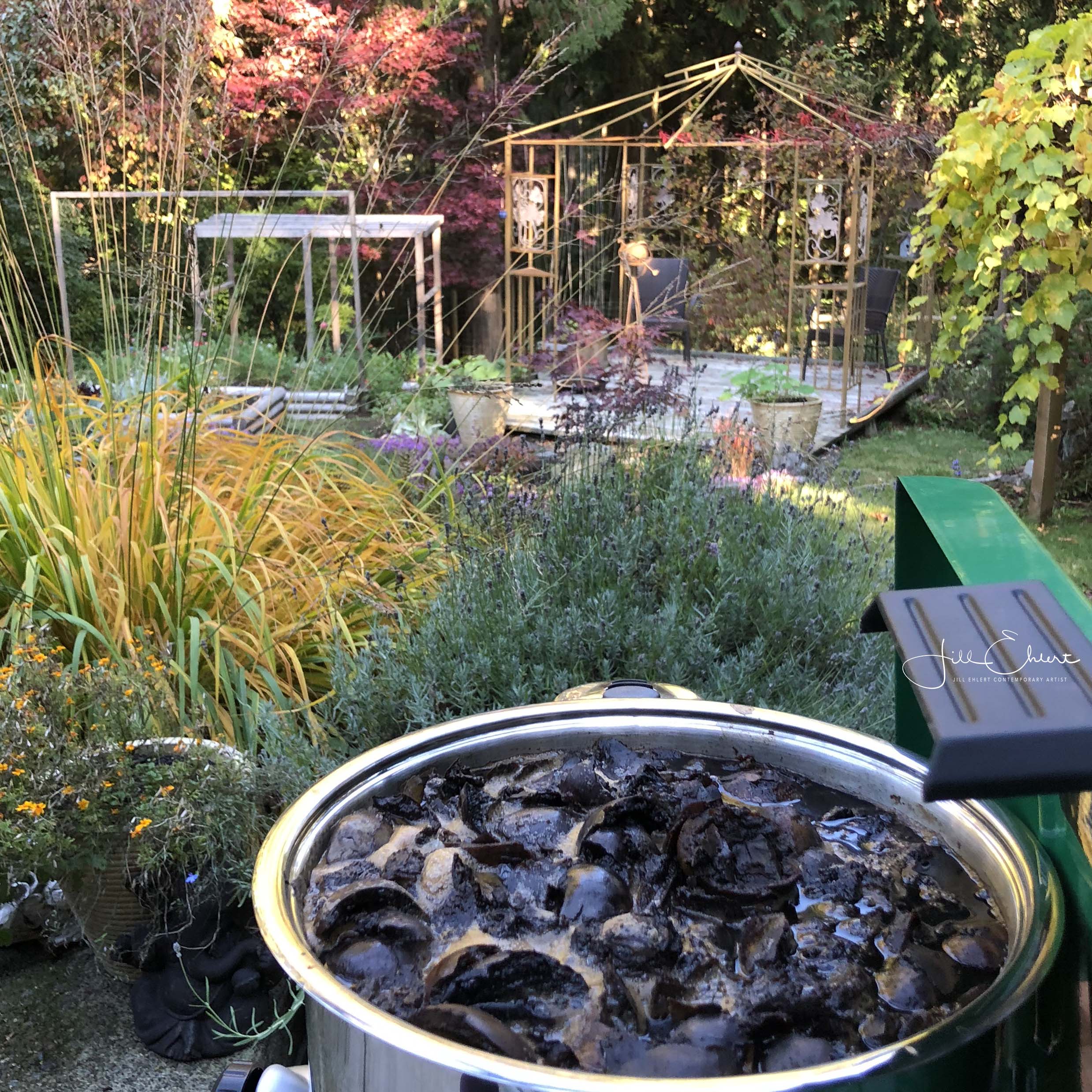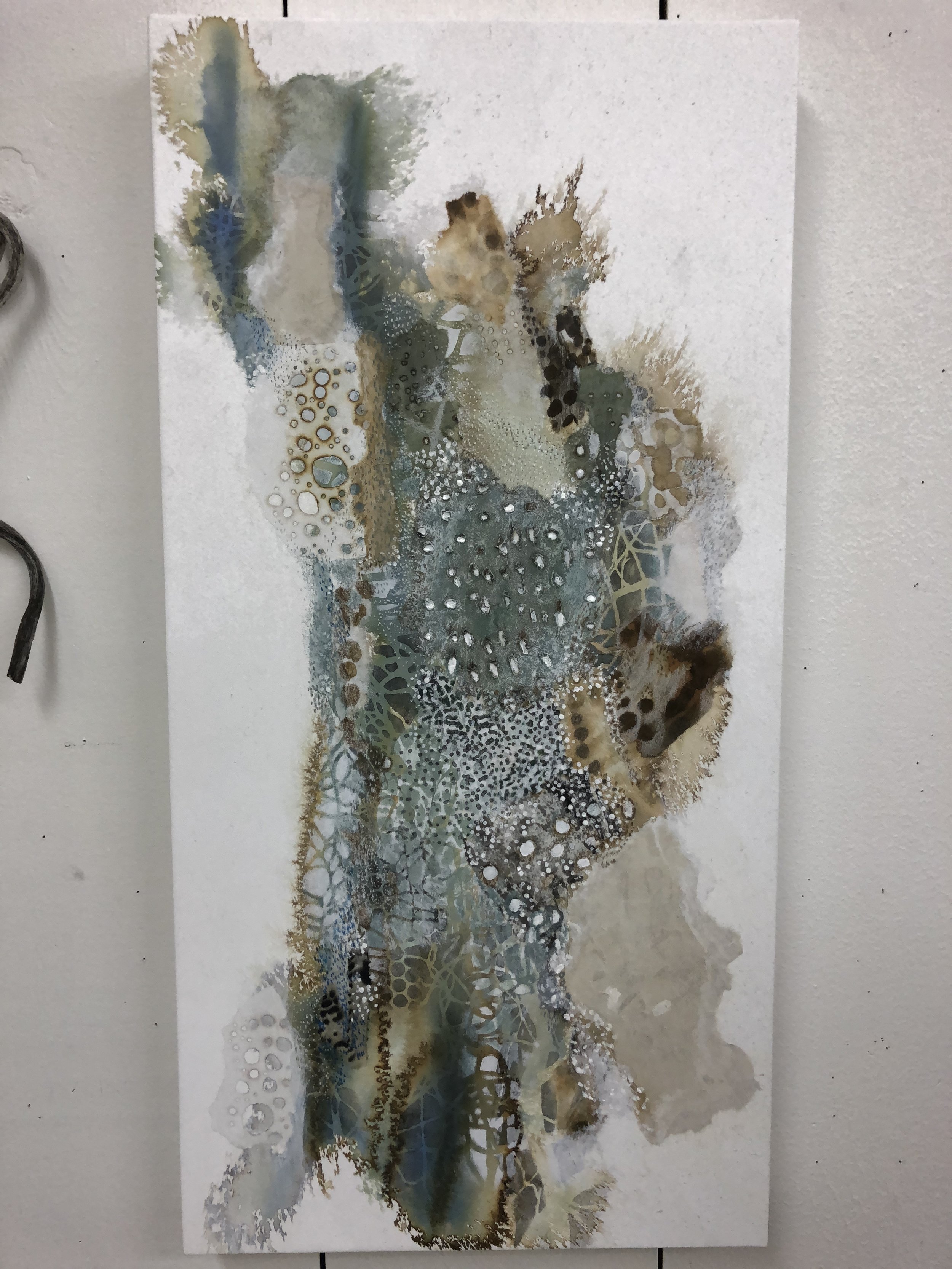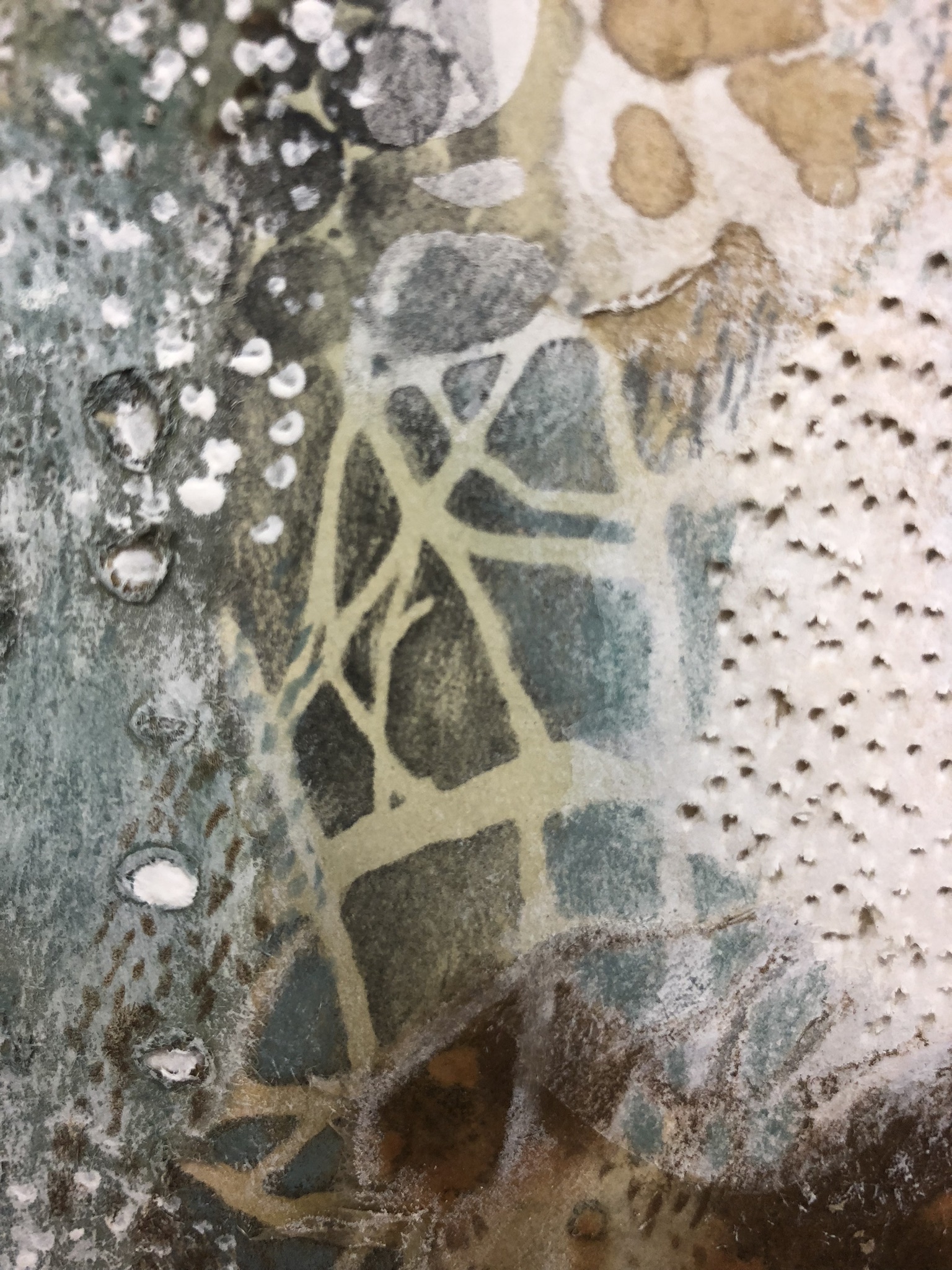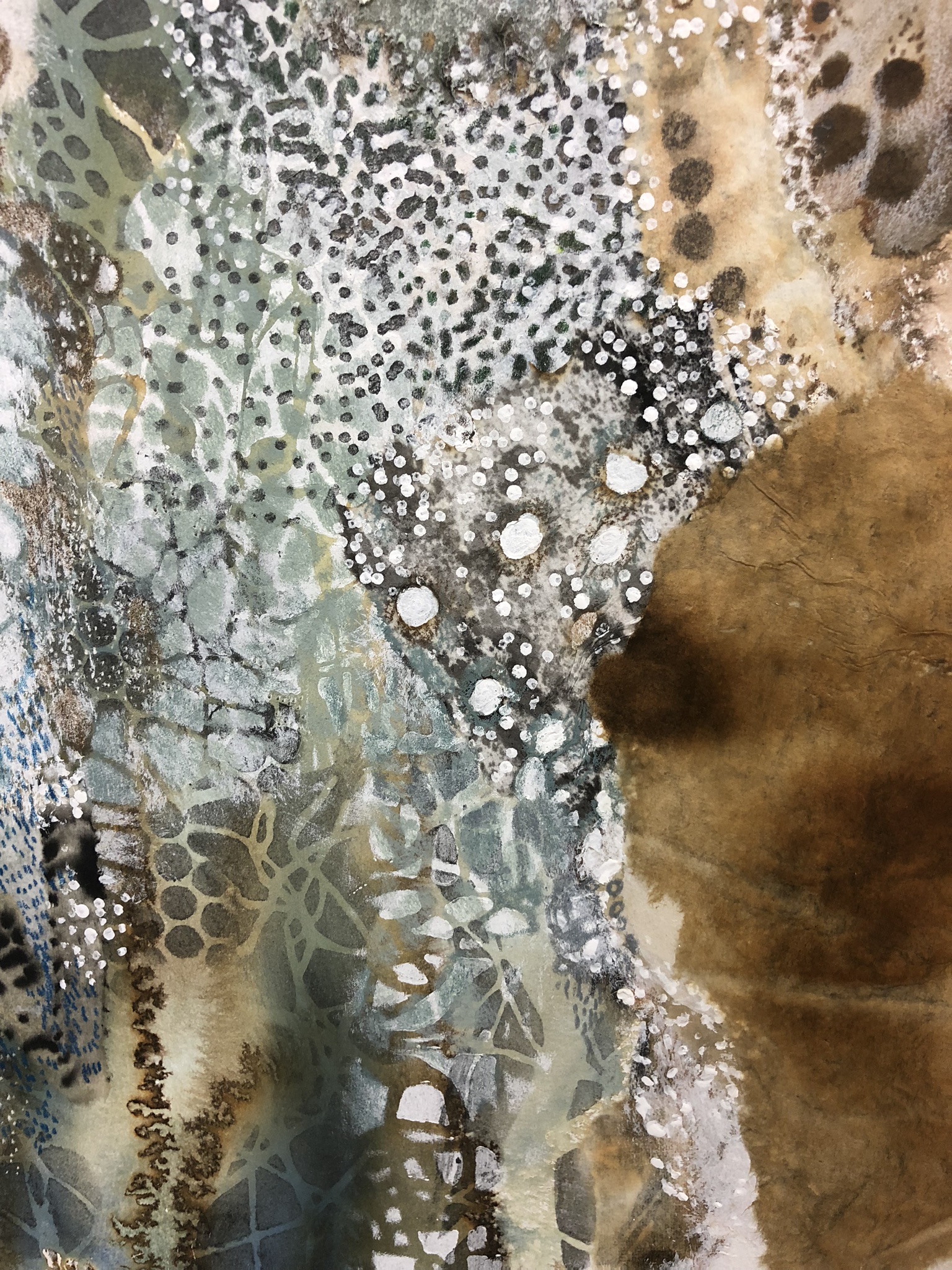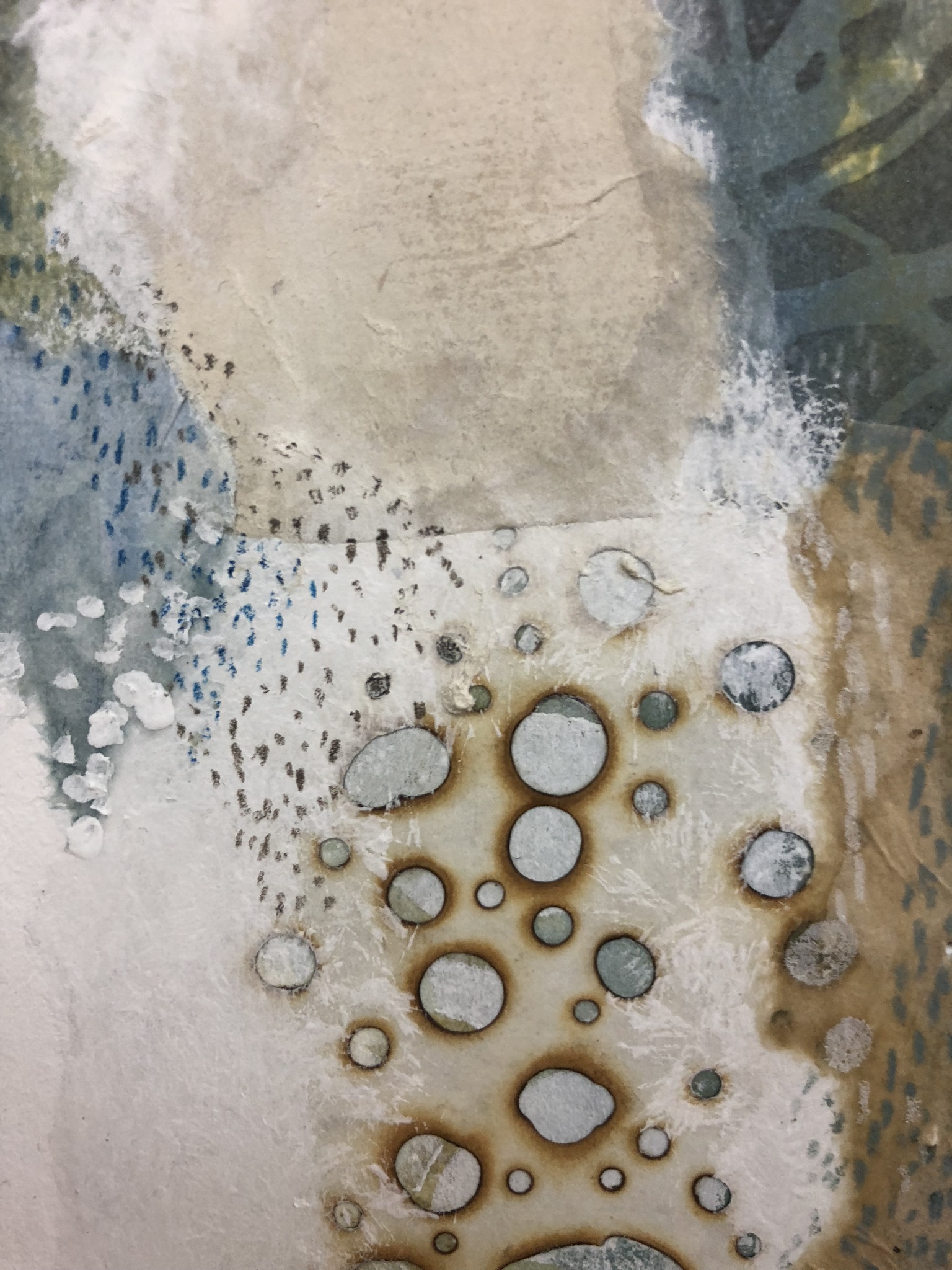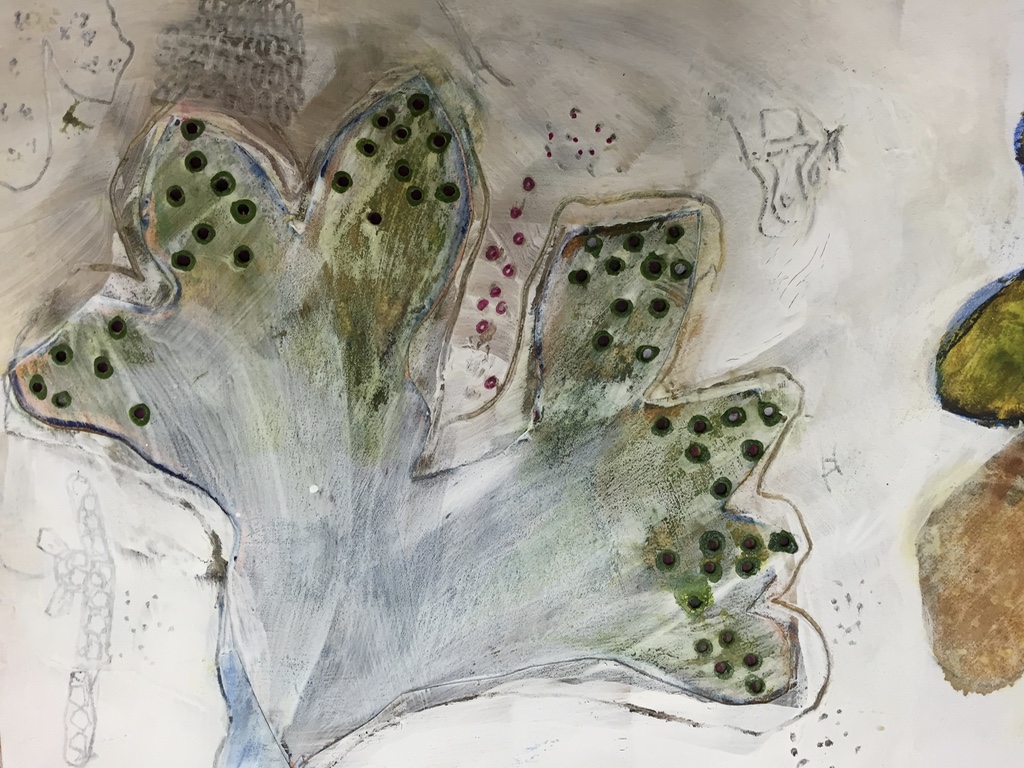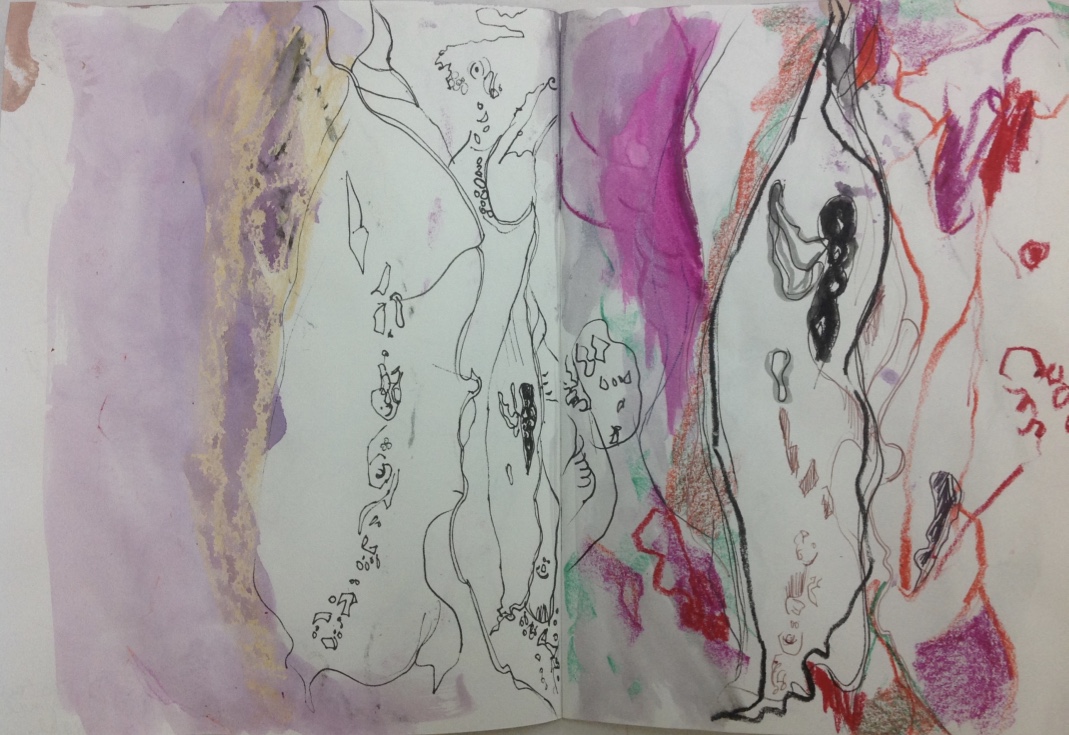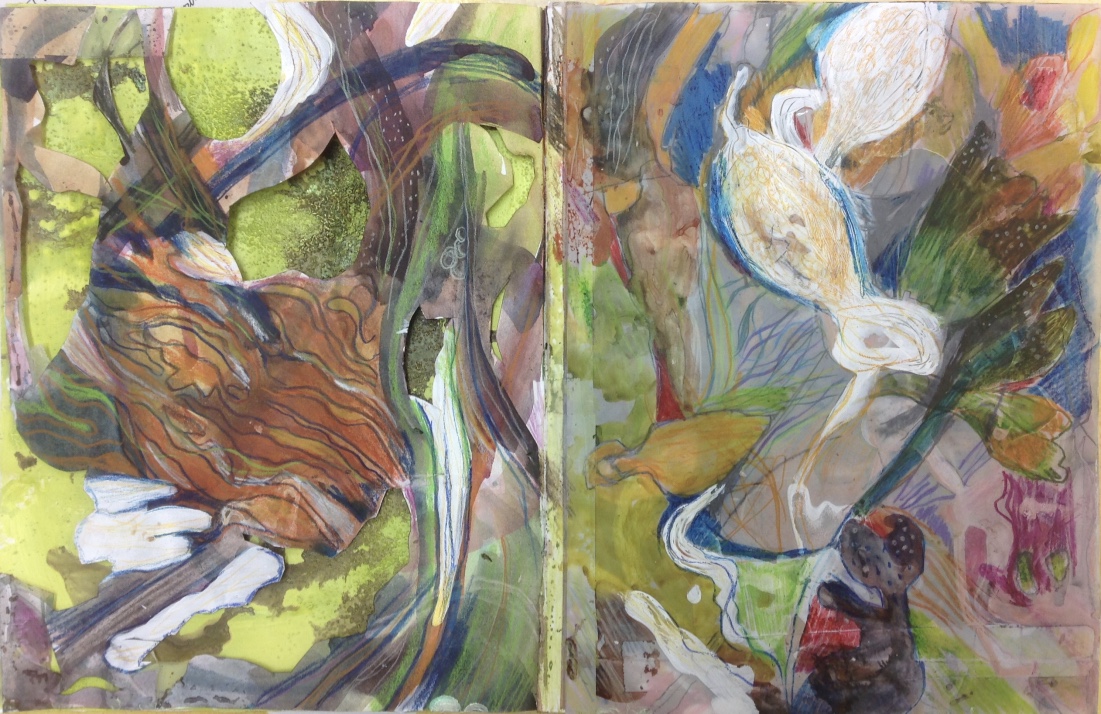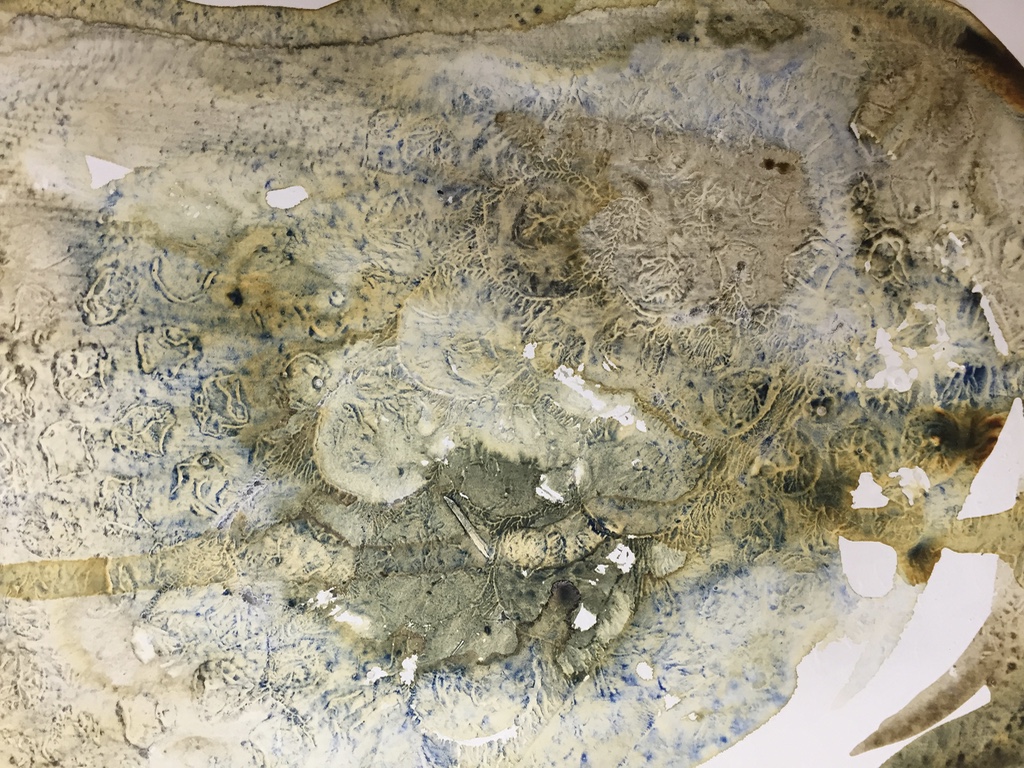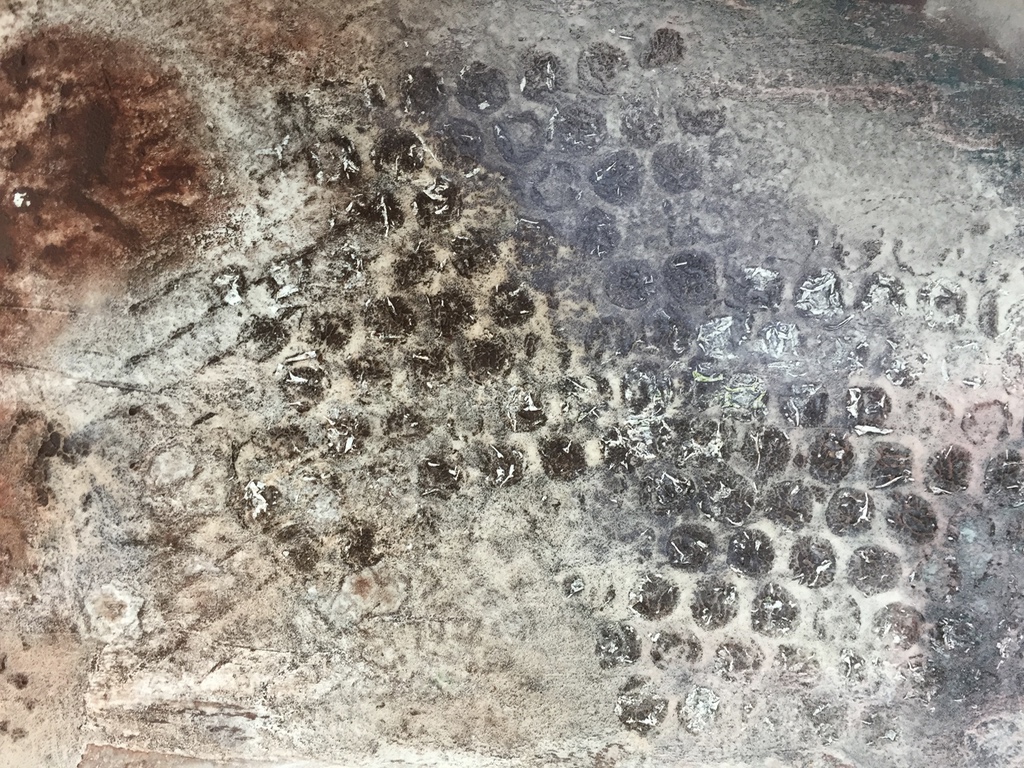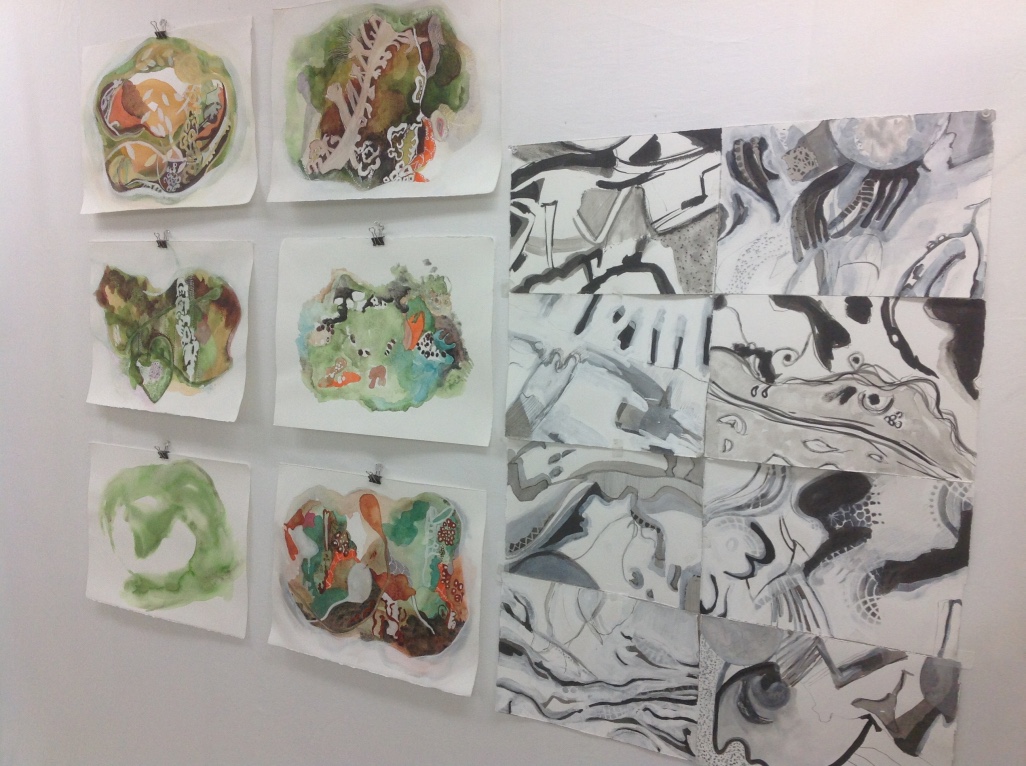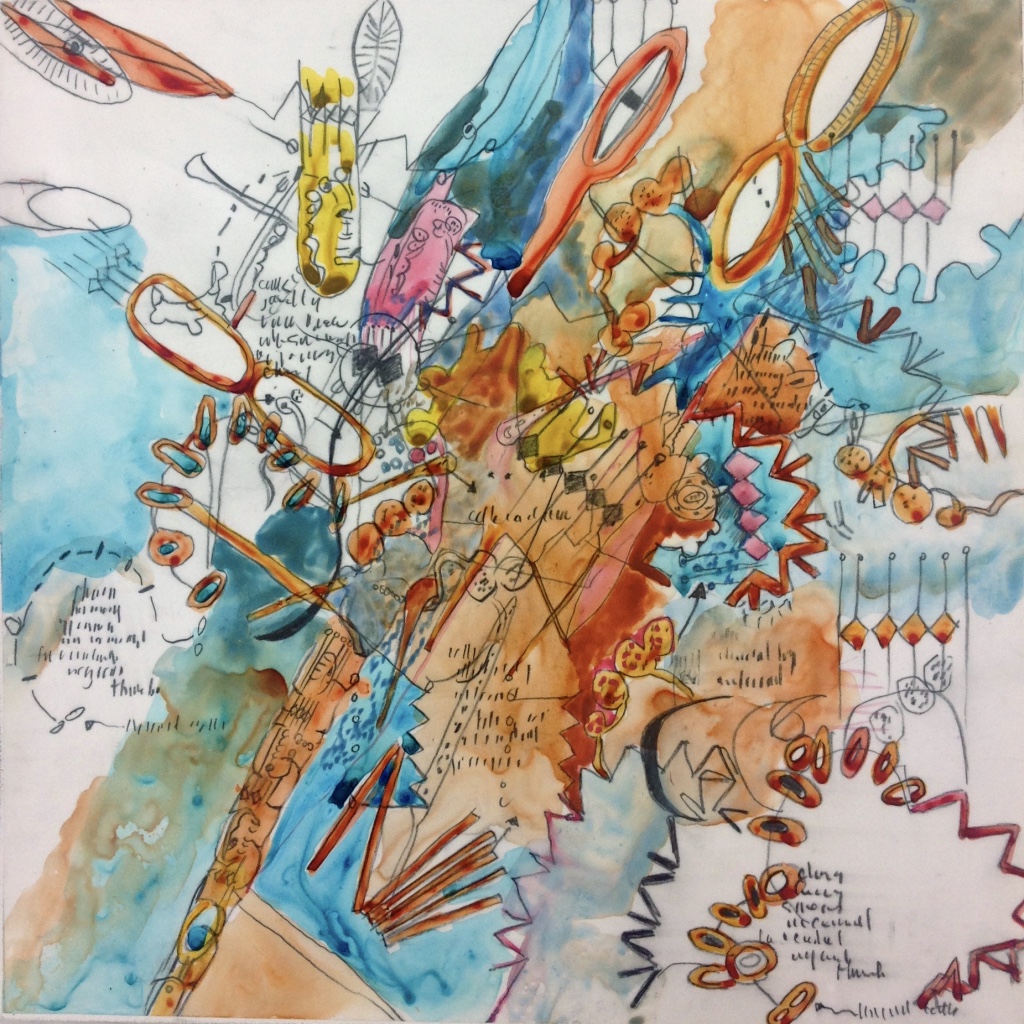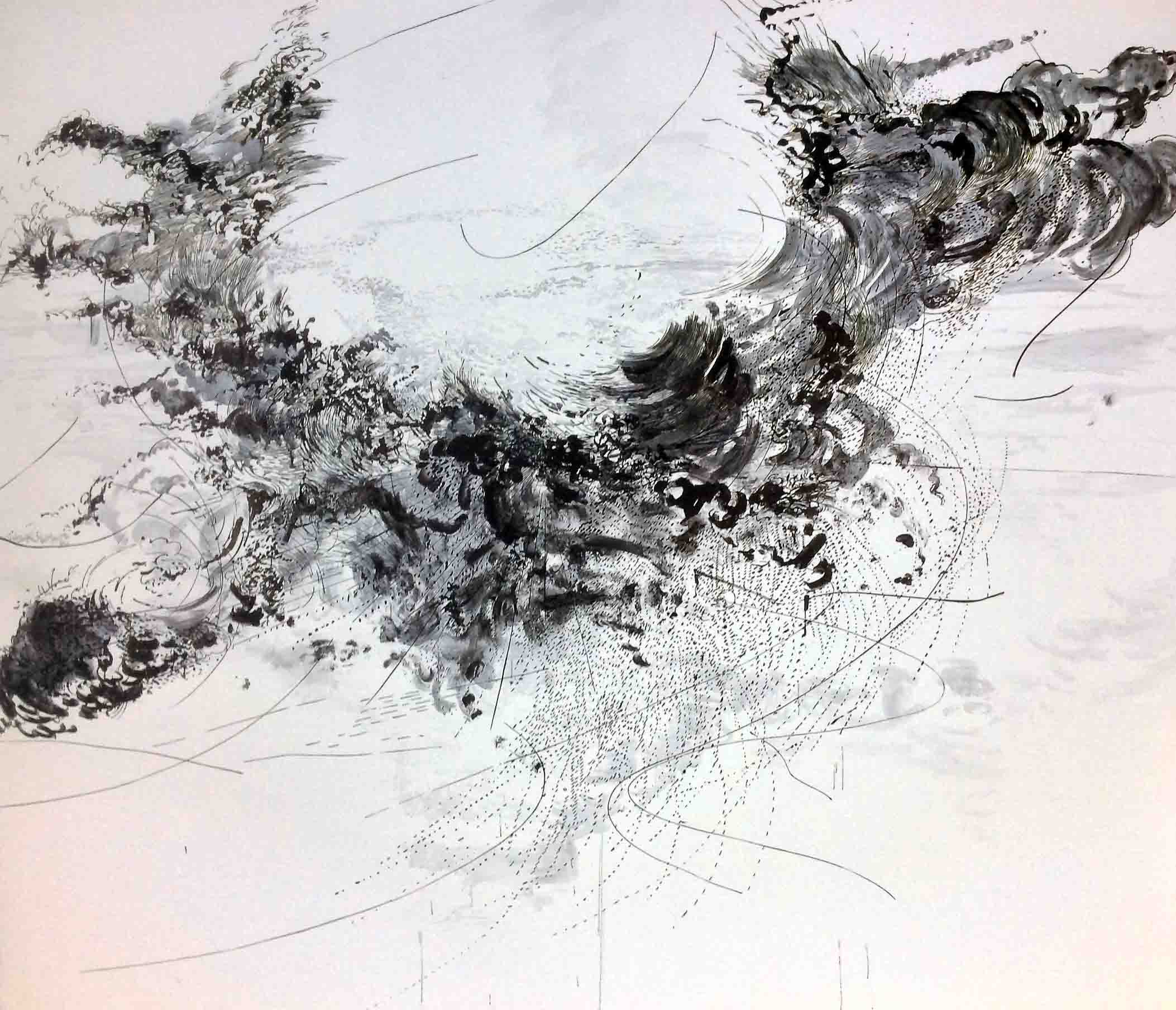In October I was inspired to make some walnut ink, based on a recipe in the book “Make Ink” by Canadian author Jason Logan. I put a call out on my Facebook page and to a to a local Facebook group asking for help in finding walnut hulls. Pretty soon I had two good leads. One was a tree in downtown Duncan, BC. in an alley behind a shoe repair store. The second lead was from an art acquaintance, who out on a walk that morning, saw a neighbour gathering walnuts- she passed his name onto me. I was able to make two large batches of about 8 cups of hulls each. I cooked the walnut hulls on the camp stove; straining and filtering the liquid. It was a lot of work, especially in the filtering process, but worth it. The colour is such a rich deep walnut colour. Love it. The two batches are called “Festubert” and “Sahtlem”, for the street and area they were grown in. I will use this ink in my drawings.
Drawing
SOLO EXHIBITION JILL EHLERT
ART OPENING - "SEAFORMS: THE NATURE OF CREATION"
SeaForms: The Nature of Creation - Mixed Media Collage work by Jill Ehlert at The Chapel Gallery opening Friday September 21, 2018 5:00-7:00 with an artist talk at 5:30. Show continues to October 31, 2018.
Click here to view more photos from the opening night and to watch a video of Jill describing her sources of inspiration and some of her art processes.
ARTIST TALK
NEW WORK IN THE STUDIO JUNE ,2018
Working away on my mixed-media collage pieces that are inspired by the intertidal zone. Having a great time.
Details of the pieces above.
NEW WORK JILL EHLERT
SeaForms - a new series
I have created a new series inspired by "Intertidal Ecosystems". Click here to see some of the works in this series.
TRAVEL
June trip to Ucluelet and Tofino, BC
Drawing inspiration from dried seaweed root balls
Holbein water brush and Van Gogh waterclours, Stillman and Birn Delta series sketchbook.
Collecting dried out seaweed root balls for drawing. They feel and look like wood and have a charred look as if they have been burnt, but they are not. These root balls have the most wonderful textures. with lots of complex networking - a good challenge to draw. Compare the root balls in the top row to the bottom three images, which are seaweeds recently washed up on the beach. The photo's taken in December 2016 and '15 show some of the many seaweed clusters containing a variety of seaweeds, which are decaying and deteriorating. Going back to that same exact spot is where I collected these dried root balls. The piles are still there but have really shrunk in size to the once huge mass and tangle. I had to really look hard to find my collection, part of which is in the last photo..
DRAWING (FEELING) WATER MOVEMENT
Overlooking Brown's Beach, Ucluelet, BC.
The quick blind contour drawings below were inspired by the water motion at Brown's Beach, Uculelet, BC as shown in the video above. Sitting up high on a rock totally mesmerized by the movement of the water below and drawing what I was feeling.
Whale Bones
I am sure these photos of whale bone will enter into my drawings. These were taken from a whale skeleton in one of the shops in Tofino.
Inspiration from the beach for further drawings and mark making
EXHIBITIONS
Jill Ehlert - solo show at the Stairwell Gallery - Victoria, BC - July/August
“Observed Transcendence”
Jill Ehlert in the Stairwell Gallery
The Stairwell Gallery is a space devoted to the visual arts in St Philip Anglican Church. The gallery is open for viewing Monday to Friday 9am to noon and by appointment.
Click here to see map of location: 2928 Eastdowne Rd., Victoria, BC, V8R 5R8
Jill Ehlert - Nature Studies
Jill Ehlert - Nature Studies
STATEMENT - JILL EHLERT
The body of work in the "Stairwell Gallery" and Sanctuary explore stages of the Life Cycle. "Birth - Growth - Maturity - Decay - Death - Renewal" - I am fascinated by the series of changes and transformations that an organism undergoes as it returns to the starting state.
The six drawings at the bottom of the stairwell are an exploration into the later stages of maturity and decay. Shrivelled forms of a day lily…the decaying structure of a Hosta leaf…the beautiful form of the poppy capsule -full of seeds ready for renewal.
The two triptychs in the Sanctuary are part of a series titled "Transformations". I combined dissimilar objects such as pomegranates, plankton, pears, decorative curtain tassels, the inner ear and the mechanical structure of a potato masher. These forms were simplified into smaller components through a process of drawing, editing and refining. I intermixed these unlikely combinations, creating an invented language of organic shapes.
The work on the right hand side of the stairwell and the little painted pieces on the bulletin board are invented idiosyncratic shapes inspired from those found within my "Transformations" series - keeping in mind natural forms and stages of birth and growth.
Studies on the bulletin board show my ongoing interest in the structure and stages of nature.
Jill Ehlert - "Bounty" 11" X 18"
PLANT STUDIES
Jill Ehlert "Small Wonders 1" 6" x 9"
WORKSHOPS
Natural History Illustration workshop that I participated in.
From October to Decemebr 2016 - I participated in this six-week online course through edX and the University of Newcastle in New South Wales, Australia. Here is a video describing the course.
The course covered:
- Core scientific observational skills
- Field drawing and sketching techniques
- Concept sketch development
- Composition for natural history illustration
- Form, proportion and structure essentials
- Drawing and rendering techniques
This was an excellent course, I really learned a lot. I would recommend this course to anyone. I am not sure when they will run it again. The website was easy to navigate and to figure out. We learned about self-assessment and peer-assessment which was really valuable. We uploaded our homework for peer review from 5 other students. We could also upload our work to a general area for all to see and comment on. There was some fantastic work being done from students all over the world. There were many short videos to view, lots to read along with images and each module had a list of resources. I came away with new skills and an excitement to get out into field to collect specimens, so some field sketching and finished drawings back in the studio. The course was free - I am not sure why...the University of Newcastle is one of five universities to offer a Masters in Natural History Illustration - perhaps this is there way of gaining interest in the program. I decided to pay for a verifiable certificate that shows I completed and got a passing grade in a course of study offered by NewcastleX.
Below are images of the pencil work that I did for the course. The photographs are field studies showing location and the ecology of the area. The ruler gives scale to the seaweed and surrounding area. The field notes show detail, colour notation, form, structure and descriptive records. Click on an image to view larger images and a slide show.
WORKSHOPS
"Collecting, Observing, Exploring" - i will be teaching this workshop.
I will be teaching this course at the Vancouver Island School of Art
Nov 21 & 22 Sat & Sun, 10 am – 5 pm
Drawing: Collecting, Observing, Exploring (DRWG w137-12)
This workshop concentrates on ways of looking and working. You will take a walk in the VISA garden and collect objects with lines, texture, pattern and shapes. Back in the classroom, you will study these sources of inspiration to extract information and interpret what you see through mark making. The focus of this workshop is to explore new ways to respond to your “collections” and to discover their essences rather than a direct representation. There will be an exploration into materials, techniques and mark making through sketching, drawing, painting, ink washes, stitching, mono printing, and stamping. A variety of surfaces will be provided: BFK, Stonehenge, Kraft, tracing paper, newspapers, tissue paper, etc. This workshop will provide a great way to get new ideas for drawing, painting and other forms of design. No experience necessary.
The following images of seaweed and barnacles are examples of how I use nature as a source of inspiration in my artwork. The body of work below ties in beautifully with what we will be doing in my next workshop titled “Collecting, Observing, Exploring” As many of you know – I have been working for several years now on an ongoing series titled “Intertidal”.
OTHER TYPES OF INSPIRATION ON MY BEACH WALKS
BEAUTIFUL RICH SEAWEED AND CRITTERS
Below are observation sketches of seaweed, along with mark making exploration and pattern studies that I see within the seaweed and detailed study drawings of their cellular structures.
Mixed Media Explorations of Seaweed and Barnacles
RESEARCHING BARNACLES AND INSPIRED WORK
CLOSE UP STUDIES OF STAR FISH WITH MAGNIFYING GLASS AND PATTERN INVENTIONS
SKETCHBOOK WORK DEVELOPING ABSTRACT IDEAS FROM ALL OF MY STUDIES AND FINDINGS.
EXPLORATIONS INTO SURFACE AND TEXTURES
SMALL FINISHED STUDIES INSPIRED BY THE COLLECTIONS, OBSERVATIONS AND EXPLORATIONS
FINISHED DRAWING "DRIFTERS" © 2014 INSPIRED BY MY PLANKTON RESEARCH 2009
Julie Mehretu
Author: Catherine de Zegher
Julie Mehretu isan American artist who was born in 1970 in Addis Ababa, Ethiopia. She studied at University Cheikh Anta Diop, Dakar (1990–91), earned a BA from Kalamazoo College, Michigan (1992), and an MFA from Rhode Island School of Design, Providence (1997). She lives and works in New York City, NY and Berlin, Germany.
Julie Mehretu creates extremely large-scale acrylic paintings that refer to elements of architecture and mapping. Her work is often epic in proportions, with some pieces being as large as of 21 by 85 feet on canvas. The paintings are visually stunning, full of movement and an energy that seems to erupt and explode outward from a centrifugal force. These paintings are built using multiple layers of drawing with ink, pencil and acrylic paint. She pushes the boundaries between painting and drawing with her highly inventive and unique vocabulary of mark making. Swirling, flowing, erratic, combustible, bursting, choppy, staccato like marks, lines and symbols populate her work.
The focus and evolution of her studio practice comes from the language of drawing. In 1995 while in art school, Julie developed a personal visual language -- a system of marks and symbols that she uses in her work to this day. She describes her visual language as an exploration that “goes back to the cellular level where language comes from” Laying down her individual marks in an indexical fashion, she reduced and deciphered the process until her glyph like forms became notational. Different artistic influences in her development are the Russian Constructivists, Kazimir Malevich, the Italian Futurists and Wassily Kandsinsky. J.M.W. Turner’s skies and the atmosphere that he created in his paintings inspire her to paint forces like she senses in his work.
Julie’s rich vocabulary of symbols and glyphs remind me of the marks and lines in the etchings of Rembrandt. Mehretu’s mark making is also influenced by her experience with printmaking and Chinese calligraphy. She is also inspired by graffiti, video games and Japanese manga cartoons.
Julie recognized that one individual mark has a sense of power or social agency She describes: "the hand and mark create a ‘behaviour’ and that groups of similar marks can shift the surface of a picture by its behaviour depending on how they are drawn” for example: aggressive or passive; some groups or communities operate with one another or become devoured by each other. She feels her marks take on characteristics and in turn calls them “characters”. These characters and clusters of marks then needed a place to inhabit where they could behave, retaliate, be self-deterministic or battle with each other.
Looking to outside references, Mehretu typically begins a painting by layering her favoured source materials which usually consists of detailed architectural plans or city maps. Her sources often incorporate schematic depictions of modern, historic or ancient buildings such as stadiums, military and industrial complexes, public spaces, airports, and financial institutions.
Julie creates these “story maps of no location” by projecting some of these references onto her support, using technical pens and rulers to trace them onto the ground. The work is preconceived and intentional. The drawing process references techniques of precision drawing by using a hard-edged geometric style. Mehretu uses Cartesian analysis throughout the research process in order to make sense of the invented places that create a context for her ‘characters’ to invade. At different points, she applies an acrylic and silica mixture which is painted and sanded smooth to create a translucent veil, which allows her to embed the drawn marks beneath creating a spatial depth.
Successive drawings traced become more abstracted through this multiple layering process. This additive and subtractive method is a transformative process that symbolizes change over history and in the painting itself. The top layer contains her painted language, which is applied loose and gestural; her calligraphic marks are painted with brush and ink through an intuitive organic process. Colour is referenced from the code colours on maps and culturally codified colours such as flags.
Mehretu’s paintings ‘depict social concerns of power, history and globalism layered with her own narrative of place, space and time that impact the formation of personal and communal identity’.
Paintings of the last few years include what she calls a ‘third space,’which emerges from the collision of the architectural drawings, her mark making and through repeated erasure. She metaphorically describes this third space “as the ruin or the un-building of space - a hybrid identity, an area of the sublime”. Mehretu describes all of these moments as being mashed together where a new potential emerges.
Julie’s central focus is always on the drawing process. She tries to understand her work through drawing; it is her point of entry and departure. Drawing is the backbone language of her practice, it informs and supports everything else in her work. Written by Jill Ehlert
For more information on Julie:
PBS Video: Art21 - This is a great video as are all the artist videos at this website
Audio interview from British Museum with Tim Marlowe and Julie Mehretu in conjunction with the show "Picasso to Julie Mehretu" modern drawings from the British Museum collection.
Magazine Interview with Julie Mehretu and Lawrence Chua at Bombsite.com
Art in America/November 2010 - article by Eleanor Heartney "Invisible Networks"
Check out Julie's work on Google Images
Drawing Now: Eight Propositions
Drawing book on my shelf:
Drawing Now: Eight Propositions
Published/ 2002 by The Museum of Modern Art - Laura Hoptman
Drawing Now, published to accompany the first major survey of contemporary drawings at The Museum of Modern Art, New York, in 15 years, contains more than 100 color reproductions of work by 26 international artists, both well-known and emerging, that demonstrate the fascinating variety of methods and approaches, mediums and scales, apparent in this old-again, new-again art. Accompanying essays by the exhibition's curator, Laura Hoptman, explore eight themes that she perceives in the field--Drafting & Architecture, Mental Maps & Metaphysics, Popular Culture & National Culture, Fashion, Likeness & Allegory, Envisioning a City, Science & Art, Comics & Other Subcultures, Ornament & Crime--and provide key impulses behind drawing's recent resurgence.
Artists Include: Kara Walker, John Currin, Toba Khedoori, Chris Ofili, Franz Ackerman, Kai Althoff, Russell Crotty, Graham Little, Mark Manders, Barry McGee, Julie Mehretu, Yoshitomo Nara, Paul Noble, Jockum Nordstrom, Jennifer Pastor, Los Carpinteros,Laura Owens, E;izabeth Peyton, Matthew Ritchie, Ugo Rondinone, Shahiza Sikander, David Thorpe, and Richard Wright amongst others.
Essay by Laura Hoptman.
Paperback, 9.5 x 12 in., 192 pages, 130 color
Contemporary Drawing Today
The past twenty years have seen an emergence of drawing as a dynamic art form.
Since the 1990s, many artists challenged and rejected “process art” of the Conceptual and Minimalist artists from the 1960's -1970's as well as the post-1980's conceptualists.
Artists of that earlier time period felt drawing was the “act of doing”, a direct method for documenting ideas, emotions or discoveries made during the creative process. The "action taken" was the work of art; the end product was not the principle focus.
Contemporary drawing artists today have connections to the working practice of nineteenth-century artists with representational references and fully realized art works. The artists of this new millennium differ from those in the mid twentieth century given they draw with intention, make choices and consider formal and abstract issues in their work.
With a resurgence in this discipline and a new found freedom, drawing artists of the twenty-first century, redefine and push boundaries in new directions. Their art sometimes flows off the page and into the real world; the visual language of the two-dimensional invades the three-dimensional merging with time and space.
Disciplines such as sculpture, video, film and performance are incorporated into this new expanded field. Drawing artists look to outside references such as cartographic language, cartooning, video games, Chinese scroll painting and calligraphy. They employ the techniques and formal vocabularies of precision drawing, scientific and architectural drafting, industrial and commercial architecture, ornamental design and the everyday object as a way to project their ideas. They draw upon notions of intimacy, subjectivity, history, globalization, memory, nostalgia and the narrative.They experiment and push the limits of non-traditional materials like rope, string, ribbon, mylar, film, magnetic tape, cable, wire, sticks, maps, boards, pins, nails, cardboard...the list is endless. Exploring methods by burning, soldering, cutting, projecting, tyeing, knotting, etc.
Drawing today has become a primary mode of expression.
Over the next week I will introduce you to artist's who employ drawing as the main focus in their art practice; as well as books on drawing artists and techniques.
JULIE MEHRETU
Julie Mehretu "When Dawns were Young" 2004 Ink and acrylic on canvas , 140 X 189 in.
Julie Mehretu is an American artist who was born in 1970 in Addis Ababa, Ethiopia. In 1977, the family fled their homeland immigrating to the United States and settling in Michigan. Mehreutulives and works in New York City, NY and Berlin, Germany.
Mehretu creates large-scale abstract paintings with a narrative content, one that reflects her interest in geography, architecture, history, and urban life. Mehretu’s favourite source materials consist of architectural plans and city maps. These often incorporate schematic depictions of modern, historic or ancient buildings such as stadiums, military and industrial complexes, public spaces, airports, and financial institutions. Julie Mehretu illustrates her social concerns of power, history and globalism layered with hernarrative of place, space and time that impacts the formation of a personal and communal identity.
Mehretu’s paintings are visually stunning, full of movement and an energy that seems to erupt and explode outward from a centrifugal force. These paintings are built using multiple layers of drawing with ink, pencil and acrylic paint. She pushes the boundaries between painting and drawing with her highly inventive and unique vocabulary of mark making. Swirling, flowing, erratic lines and symbols populate her work.
Drawing workshops at VISA over the summer
Vancouver Island School of Art
MAKING A MARK - June 25, 26, 27 2012 taught by Danielle Hogan.
This workshop focuses on the most basic element of drawing: the linear mark. It explores the variety of ways a mark can be used as a form of expression with a focus on developing a personal mark in drawing. Artists include: Jasper Johns, Brice Marden, Terry Winters, Sol Lewitt, Raymond Pettibone and Dominic McGill. Fionna Banner, Robert Smithson, Louise Bourgeois, Brice Marden, Sol Lewitt .
NATURE & SCIENCE - August 30, 31, September 1 2012 taught by Wendy Welch
Nature has long been a subject of drawing from scientific diagrams to a range of purely observational sketches. Focus in this workshop is on integrating the scientific with the expressive approach towards a natural phenomenon or object. Workshop is comprised of hands-on exercises, critiques and visual presentations of artists doing related work. Artists discussed include: Russell Crotty, Vija Celmins, Ellen Gallagher, Sandra Cinto and Robyn O’Neil.
Inventing a fantastical flower using magazine collage, combining mechanical parts and organic.
Fantastical Botanical Collage - Jill Ehlert
Fantastical Botanical Watercolour based on the collage - Jill Ehlert
Reinveneting & Rearranging the Landscape
Fragmented Landscape Drawing - Jill Ehlert
DIAGRAMS
Invented Nature Cycle Diagram
Invented Life Cycle Diagram
Invented Process Diagram
Spattering tea on the paper, create a process.
DIRECTED STUDY
I just finished my 12-week "Directed Study" at the Vancouver Island School of Art (VISA) from this past winter semester. I met with Wendy Welch, the director of VISA every second week.
VISA website describes the Directed Study: This course gives students an opportunity to work on a project under the supervision of a faculty member. Students submit an application that contains a proposal outlining what they intend to work on in their directed study. At the end of the project, students present their work to their advisor and one other faculty member for a final critique. Directed Studies can be taken up to a maximum of four times (Directed Studies I, II, III, IV). Days/times are scheduled on a per person basis. The student and advisor meet on a bi-weekly basis on a specified day and time for the duration of the semester. Directed Studies Students meet for one hour every two weeks and receive 36 credit hours upon completion. Prerequisite: enrollment in the Diploma Program or with permission of the Director.
Final critique day with left, Danielle Hogan, middle, Jill and right, Wendy Welch. Wendy was my advisor and Danielle wass the other faculty member that was part of my last critique day.
"Flow" - JIll Ehlert © - 48" x 48"
Panorama of the installation
I had 23 new works hung in the "Slide Room Gallery" for my critique. To see all the drawings click here.
- Jill Ehlert © 22" x 30"
New drawing
Jill Ehlert © - Detail
New Tryptych - Transformations series
"Changeover" - Jill Ehlert © - 22" x 90"
"Changeover" - Jill Ehlert © - Left side - 22" x 30"
"Changeover" - Jill Ehlert © - Middle - 22" x 30"
"Changeover" - Jill Ehlert © - Right side - 22" x 30"



